|
A Short Discourse on (Home
Theater) Surround Sound
Here are home theater
setup suggestions and a mini-history from the original
THX to "now", and towards the future. If you're
thinking about going from stereo to surround, or from
5 channel surround to 6 or 7 channel surround, read on...
Since everyone in
HOME situations don't always build or install rooms using
an acoustics consultant (or even a protractor) the results
will vary and nothing is cast in stone. There are always
personal preferences, decor objectives, etc. which override
everything else. And while this is all my opinion gleaned
from 55+ years in audio, your mileage may vary.
Everyone is entitled
to operate their sound system as they see fit. If you
enjoy it and it's right for you; great. But I like to
assist people by getting all the wrong things out of the
way first (speakers in the ceiling is always good for
starters) so that you don't wind up with a room full of
equipment which annoys you and you feel you're not getting
the bang for the buck you feel you deserve.
I can't tell you whether
to prefer red wine or white wine - that's up to you -
but the careful convergence of setup ideas for the room
acoustics, speakers, electronics, AC power, and wire hookup
all play a part in the sum total of your overall enjoyment.
Whatever you do, enjoy experimenting.
You could discover something great!
And don't forget that
a sound (and video) system is definitely a weakest-link
phenomena. ONE loose and crackling wire, in an otherwise
pristine system, will cause the owner of the system to
remark that the whole thing sounds like junk, or worse.
I would suggest that the utmost care and attention be
paid to what you might initially think is the smallest
detail - such as contact cleaning and enhancing chemicals...
and even labelling wires! You'll thank yourself later.
SOME PSYCHOACOUSTICS
Perhaps because of
genetic, physical, or chemical attributes, some people
are "Bass Freaks" or "Treble Freaks",
etc. Some people will listen to a song and not even notice
the bass is present, while some won't pay any attention
to the singer but know every bass line. The point is people
are different. You may like something completely different
than what any artist, record producer, or engineer ever
intended! There is, therefore a very wide range of what
you might personally consider "loud enough"
or "enough bass" or "too loud", etc.
Fortunately the engineers at THX studied this very carefully
and came up with a technical set of parameters designed
to minimize the confusion.
The whole concept
of surround sound is a complex psychoacoustic phenomena
which if set up well is convincing, and if set up poorly
is annoying at best, and becomes frightening to some,
because people are not used to, nor prepared for, sounds
coming from behind them without turning around to see
what the sound is; and in the case of a movie this becomes
a momentary distraction instead of an emotional concentration
toward the screen.
Many people put surrounds
too high or behind them -and then turn them up too loud
and the result is not pleasant. Placing the surround speakers
at the most desirable angles and getting the most desirable
room coverage / splay will do wonders to smooth out the
desired immersiveness of the experience.
My suggestion is to
START with everything set at a calibrated, neutral position
(and that includes the correct geometric placement of
the speakers as I will explain) and then work outward
from there, continually fine tuning your system mechanically
and electrically until you feel it sounds right to you.
This is not a trivial issue. Expect to spend a few weeks
at this.
There are methods
of setup which are DESIGNED and SUGGESTED if you want
to experience the seat-of-your-pants, this-is-how-they-hear-it-in-Hollywood
type of setup. There are suggested setups for those who
might like classical music and like the feeling of being,
for example, in the 5th or 15th row center. This also
brings up a whole series of questions such as, "How
was the piece mixed? From whose vantage point? From the
guitar player's perspective? From the conductor's perspective?
From the 5th row center concert seat? Nowadays, DVD's
with movies on them intended for home release are specifically
mixed with the intent of being played back in a home setup,
where the speakers are essentially near to mid-field,
at perhaps 4 to 15 feet from the listeners' ears. The
soundtracks for the Theatrical release of the same film
is usually different: it is intended for playback in a
much larger space, with the speakers much further away
to begin with, and therefore the spatial characteristics
that are an integral part of the mix are different between
these two different releases.
One way to approach
this entire setup phenomena is to get the stereo image
correct first, before concentrating on the overall home
theater experience (meaning 'surround sound' ) as a whole.
Some people concentrate only on the picture and the visual
phenomena, and then stick some speakers up wherever they
can. That result is often disappointing. If, after the
system is completely set up, you find yourself "leaning
in" to the sound, subconsciously trying to get "closer"
or "more immersed" in it then I would suggest
repositioning your seating so you are somewhat closer
to the picture, then reorganize the speakers. Sometimes
a good way to determine speaker placement is to set up
ladders with boards between them and keep moving things
around until you are convinced things are the way you
like them. Another method might be to hire an acoustics
consultant/studio designer to get it right the first time!
BRINGING THE MOVIE THEATER
HOME
Besides the simple
psychoacoustic effect of the stereo image, there is an
even larger psychological effect when the sound is coupled
to picture. The HIGHER and WIDER the placement of the
L and R speakers are the more "Hollywood" the
effect. The closer together and lower the L and R are
(to a certain extent) the more "intimate" the
effect.
The Center Channel
is mostly for dialog, and the L and R are
mostly for M&E (Music and Effects). Historically,
music engineers/mixers have only had a stereo pair
to work with, and all the LR placement and panning heard
by you the listener was based on the psychoacoustic phenomena
of the phantom center channel.
But movie engineers
and mixers have had a REAL center channel to work
with, and so operationally we now have the following sub
categories:
Music mixed in stereo
Music mixed in surround (5 channels)
Film mixed in surround for the theatrical release.
Film mixed in surround for the home DVD release.
Different film mixers and rock n roll
mixers have rather varying operational philosophies about
all of this. Do not expect to play a movie DVD and then
switch to a rock n roll CD and then switch to a classical
CD and not expect to have to adjust things. This brings
up a serious point: Just because you think your system
is calibrated, there is such a wide range of program material
differences that you essentially MUST adjust each and
every disc -- perhaps each and every song, if you want
to lean towards being an audio perfectionist.
For the movie, the
real C channel is essentially for dialog, and therefore
should be placed as close to the spot on the screen where
the actors mouths are! Unfortunately this means right
in front of the picture, which of course we typically
cannot do... so in the case of a projection screen, it
MAY be advantageous to place the speaker behind a perforated
screen; in the case of a tube, Plasma, or LCD picture
it should be placed below the picture if possible. The
L and R can go somewhere near the centerline
of the picture, or a little higher. The L, C
and R tweeters do NOT necessarily have to be lined
up as long as they are not too far (many feet) away from
being in a line. In other words, if the C is below
the picture, the LR might be on a line 2 or 3 feet
above where the C is. When figuring out these angles
and setups, it is a good idea to make the subtended angle
of the L and R speakers 60 to 75 degrees,
with 60 degrees being the preferred number. More about
this will be shown in the diagrams below.
Placing all 3 front
speakers too high up such as in a row above the picture
near the ceiling is generally not a good idea and is to
be avoided whenever possible. Among other acoustic anomalies,
this often causes the audience to "lean in"
to the sound, tightening the occipital muscles as opposed
to relaxing them, and the result is an experience which
leaves the viewers tense, not relaxed.
However there is an
interesting phenomena with a moderate room and the subwoofer
in the front somewhere: when the younger 'kids' are sitting
on the floor as they often do, they love the bass. So
they are sitting nearer the sub and the higher frequencies
are splaying sort of over their heads. The more mature
and elderly, who usually do not like bass so much, are
more in the direct field of the higher frequency drivers,
and also get somewhat less bass. So now, rather than attempt
to get the sound "the same" everywhere in the
room, (the concept of making the room "flat")
we have used the natural acoustic phenomena and anomalies
of the room to accomodate the auditory desires (real or
imagined) of the listening audience. Do not underestimate
this phenomena! I would suggest getting the sound "right"
for your main "sweet spot" seating area, and
allowing the natural sound patterns in the room to then
be used to their full advantage --- even to the point
of intentionally UN-balancing the room somewhat. Use the
anomalies of the room to your advantage! Have a mother-in-law
who hates bass? put her in the null. Now everyone is happy.
Once the speakers
and the sound system is adjusted properly, it should essentially
disappear into a continuum of surround sound, where the
localization appears real and smooth; which is to say
if some dialog appears as if its coming from over your
head then it isn't set up correctly!
THE STUDIO vs THE HOME
In a studio, the front
speakers are usually placed in an arc because we're really
dealing with panned mono signals, and the easiest way
to help to ensure that all the levels are the same, and
in true electrical phase with each other, is to place
the speakers the same distance from your head, in an arc.
But at home, many people simply put the speakers on a
straight line and adjust the levels [to be the same] accordingly.
The EARLY DAYS of HOME
THEATER - ENTER THX
Once we get past the
phenomena of stereo, we arrive at the next historical
stop: the suggested THX setup with DIPOLES placed at 90
degrees. The listener is sitting in the null of the out-of-polarity
(often somewhat incorrectly stated as 'phase' - they are
actually "180 degrees out of phase") surround
dipoles, and the dipoles are splaying the Ls Rs
outward along the walls of the room. This decorrelated
[side] splay gives the listener the sense they are in
a large(r) theater.
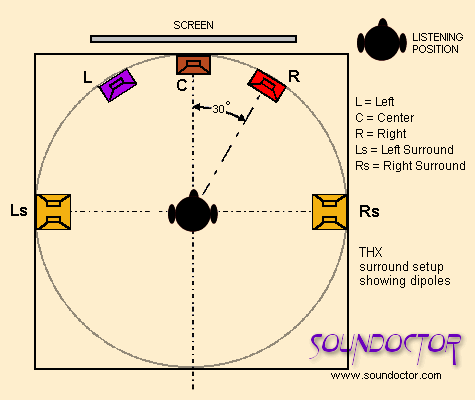 |
| Fig
1 - one of the original THX SETUPS |
Notice in the above
diagram there's NOTHING behind you. (Of course many people
place the surrounds "anywhere" because that's
the only place they'll 'fit' or 'go'.) Some people put
the "surrounds" in the back, or incorrectly
stated, in the "rear". This is psychoacoustically
and psychologically wrong. Tom Holman (and others, including
myself) found, after much experimentation, that sounds
from directly behind frighten the young and the elderly,
and in fact detract from the theatrical experience, and
cause people to turn their attention away from the screen
toward the offending sound.
The THX phenomena
did and continues to do a lot for the industry by not
only specifying minimums, and by continually exceeding
these minimums and raising the bar so that manufacturers
are always striving to build a better product. If you
were to do nothing else than buy all THX approved products,
and blindly hook them up, and set the switches to the
THX position, you would at least be assured of a minimum
theatrical experience which is quite respectable and satisfying,
even if you were not an audio, nor video, nor home theater
expert. Often, this is the best and certainly easiest
choice.This makes the entire setup painless and almost
plug-and-play!
Even following the
THX guidelines, you can expand and extrapolate on their
good foundation by making things "bigger"; specifying
for instance a higher powered version of all the equipment
so that the overall experience is maintained at a high
level but there's MORE of it still.
Of course all the
great equipment of the world cannot sound good if it is
hooked up wrong, adjusted wrong, or set up in a space
which is an acoustic nightmare. You would not want to
listen to the best speaker in the world if it were placed
in a glass shower stall with continuous reverberation
which builds up to complete distortion. Therefore there
has to be at least some attention paid to the room acoustics
and its acoustic surroundings, which become part of the
overall audio (and theatrical) experience.
There were some speakers
intended for "surround use" which were dipoles,
as originally suggested by the THX setup, and as shown
in FIG. 1. There were also some speakers which were just
like the speakers at the front of the room, i.e. "front-firing",
(out of the front of the cabinet) and these were placed
at the Ls Rs surround positions.
Then Ken Kreisel at
M&K invented the Tripole, people in studios put the
Ls Rs at 110 degrees of arc from the "C",
the ITU and the AES published their suggestions, and that
gives us the world "standard" 5 channel surround
sound setup. This is typically how things are set up,
monitored, and mixed in studios.
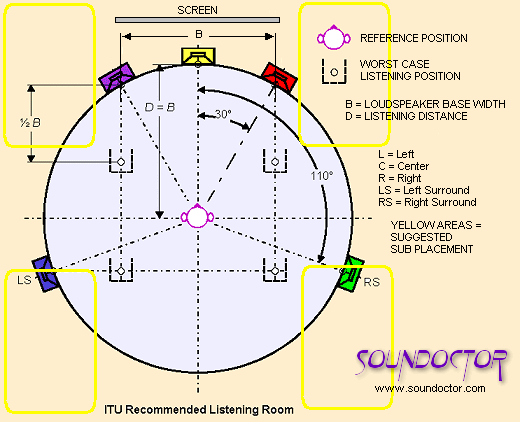 |
Fig
2 - Typical 5.1 suggested setup.
This is the STANDARD SUGGESTION for "SURROUND
SOUND". |
This diagram does
not presuppose you put speakers in a circle - although
that would be best. The supposition is you extend the
angular lines outward until they intersect a wall and
you put the speakers on that wall. IF front-firing speakers
are used, (at the Ls Rs positions) you aim them
as shown. If TRIPOLES are used, you place them flat on
the wall, so that the correct ratios come out of the [sides
of the] box and splay on the walls.
6.1, 7.1 and MORE
Many receivers have
a combination of proprietary "surround " modes
which support a 6th or a 7th additional speaker. To make
a very long issue short these surround modes are usually
digitally synthesized and additionally processed and reverberated
from the original 5 channels. I suggest to most people
that the better path is to set up a "better"
5.1 system (which is how things are mixed) than a more
diluted 6 or 7.1 system. Merely adding sound sources to
a room does NOT enhance intelligibility in any way ---
to the contrary, often you are adding 2 more sources but
have not changed the relative levels of the rest of the
speakers therefore the relative level of the all-important
Center dialog channel is now lower!
The setup below shows
a typical setup using a moderate to high-end home theater
receiver or control center such as a Denon, Marantz, Pioneer,
Harman, some Yamahas, etc. They typically have a pair
of Lb Rb outputs which for the most part ARE NOT
DISCRETE! They are resynthesized from the 5 channels that
already exist, and the signal(s) sent to the back contain
either a simple delay and/or artificial reverb and digital
processing to MAKE THEM SOUND AS IF THEY WOULD IF THERE
WERE REAL CHANNELS BACK THERE. Certain decoding methods,
such as DTS have one (6.1) or more (7.1) channels and
those 'extra' back channels are synthesized and then encoded
AT THE TIME OF ENCODING, therefore they are already on
the disc.
Certain other companies,
such as Yamaha and Lexicon, have their own proprietary
surround resynthesis schemes which sometimes suggest that
speakers be placed in locations that can only be described
as "unconventional". Even so, some of the schemes,
although considered odd by the engineers and producers
who set up and mix the original music, are nonetheless
very interesting, proving that the art of audiophile experimentation
is not dead!
To take this even
one step further, Tom Holman has demonstrated a 10.1 channel
sound system, (and more...) and as the software upgrades
for the various receivers and decoders matures, we may
expect to see all sorts of unusual and proprietary processing
tricks emerge.
In some rooms which
have a ratio of very long to wide; or are acoustically
'dead' or dampened, the addition of these channels 6 and
7 MAY be somewhat beneficiary. The overall suggestion
is to not go to a 7.1 setup if it is going to compromise
the "correct" 5.1 setup in ANY way.
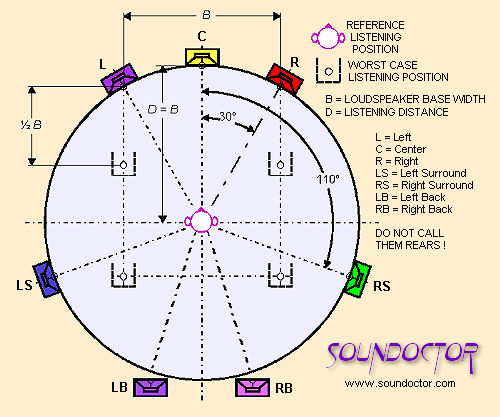 |
| Fig
3 - 7.1 Channel setup for the home theater |
If you feel you MUST
set up 7 channels, do it this way. The angles of the Lb
Rb speakers becomes part of a psychoacoustic balance:
if you think there's sound that DOESN'T BELONG behind
you, it will be frightening. If it properly blends into
the scenario of the film and the rest of the acoustic
phenomena happening in the room, it will feel "correct".
It would seem that firing a speaker right into the back
of your head cannot be correct. My suggestion is to make
the back pair about half the subtended angle of the front
pair, therefore about 30 degrees a part. See below for
some other alternative surround setups (either 5.1 or
7.1).
But here's a catch:
we don't actually need Lb Rb; (the back channel
resynthesis) we can make this 2nd pair of surrounds ALSO
be Ls Rs, just like in a movie theater, where there
are almost always multiple sets of Ls Rs. In fact
we can have multiple rows of listeners, and multiple rows
of Ls Rs; all we need are (usually) dedicated channels
of amplification to drive each "pair, like this below:
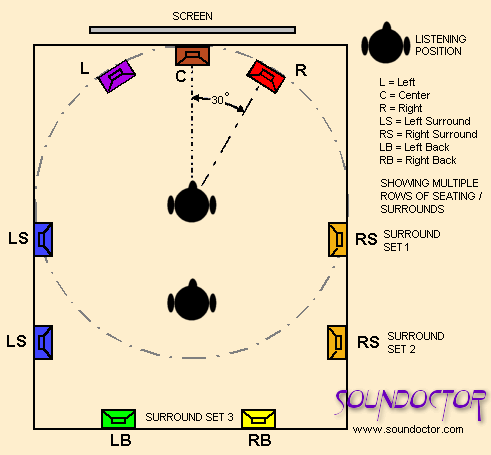 |
| Fig
4 - Multiple Surrounds, such as in a larger home theater
presentation room,with multiple rows of seating. |
You will notice that
the surrounds are placed so that each row of listeners
gets hit by a surround pair at about 110 degrees of arc
from the C spaker. So Surround sets 1 and 2 can
be Ls Rs, and surround set 3 can be EITHER Ls
Rs -OR- Lb Rb, depending upon if the receiver
in question supports it. There is absolutely nothing wrong
with using multiple sets of surrounds. Some receivers
have the option to adjust the delay timing to these multiple
sets, so that the additional few milliseconds of delay
to these "rows" makes the room seem larger.
In some instances,
notably if the room is reflective, close to square, or
the entire listening area is quite small, the addition
of a Lb Rb pair may muddy up the whole thing and
may detract from the intelligibility of the C channel
dialog, because you're adding 2 more uncorrelated sources,
with different delay timing into the equation, and this
muddys up the entire soundfield. This may cause the C
dialog channel to be less intelligible because now the
Center dialog channel represents LESS of the overall averaged
sound level.
In a room which is
very rectangular, (and it depends where you are sitting
in this room) very dead (plush carpets, wall hangings,
soft furniture, acoustic trapping) the Lb Rb surrounds
may be VERY beneficial.
A "REAL" CENTER
CHANNEL vs A "PHANTOM" CENTER
What's the future?
The industry, now that real multiple panning output plug-ins
are available for DAW's, may be moving in the direction
of "Panning Pairs" that is, where every pair
of adjacent speakers has ITS OWN PHANTOM CENTER IMAGE,
just like a stereo L R has its own phantom center.
The film industry
has ALWAYS had a center channel speaker for dialog, and
places M&E (Music & Effects) in the L and
R.
The MUSIC industry,
(i.e. rock n roll, classical) has NEVER had a discrete
Center channel; they have always used a PHANTOM center
image formed between the L R. This has formed a
remarkable dichotomy in the world of mixing which is continually
unresolved. "Where do we put the voice? In the C
only, with a little reverb in the LR?" (that's
the film mixer talking) vs "Where do we put the voice,
in the LR with some in the Center to make it "feel
" correct? and if we have the voice in all three,
then what happens when it's downmixed to stereo? We're
not used to this available Center channel --- help!!!"
(that's the music mixing engineer speaking...) There are
always issues and workarounds.
So now if we put every
pair of speakers 60 degrees apart, that gives us this:
(6 x 60 degrees = 360 degrees; while the 7th speaker [the
Center] is ALWAYS separate and distinct). That setup then
looks like this:
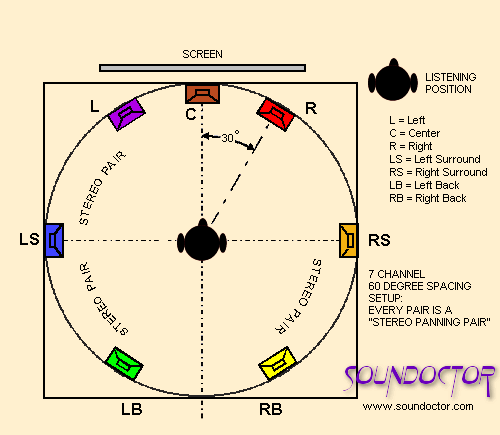 |
| Fig
5 - 60 degree splay setup - part of what the future
may hold... |
Now there's a phantom
center image between each pair, (between L
and R; between L and Ls; between
Ls and Lb and so on, around the room) and
yet the speakers are "placed" in the room in
such a fashion as to be approved by spouses (of any gender)
and interior "designers" and "decorators".
The setup becomes "easy".
This gives fabulous
spatial localization even with systems which have less
than ideal phase linearity (important) or frequency linearity
(somewhat less important); or where, say, one set of speakers
on one side of the room is higher than on the opposite
side of the room, because that's the only place you could
"stick" them.
But guess what? !!!!!
The Ls Rs are at 90 degrees to the 'main' listener
again, just like in the original THX setup, except that
the original THX setup called for DIPOLES at the sides
and these later diagrams call for front-firing speakers
all around.
One very desirable
solution is to set everything up so you can, in fact,
hear everything how the producers, directors and engineers
intended, and this holds true for both the visual, the
audible, and the sum total of the theatrical emotional
experience.
Once you understand
that entire philosophy, then you are able to modify it,
if you so choose, to fit in with your lifestyle, room
decor, budget, and technical adjustibility, so that the
end result is most pleasing to you.
MONITOR or PLAYBACK?
You could also strive
to make your room seem like a pro studio, setting up the
room with the speakers not necessarily against the walls,
but in a much tighter circle as shown in the diagrams,
perhaps, say, in an 8 or 9 foot diameter circle. What
that does is tend to focus you in this tight sound [near]field,
where you hear every nuance of what is in the mix, and
LESS from the room; kind of the opposite of the philosophy
of widely splaying tripoles (or dipoles). You are in the
nearfield, and you do NOT really hear the first order
reflections, because you are so tight in the circle. By
the time the sound hits the walls and comes back to the
inside of the circle, the Haas or precedence effect has
long since taken over, and the room splay now becomes
a much smaller percentage of the overall sound.
For an even added
tightness, and the MOST up close and personal mix possible,
treat the room acoustically to help make it flat, neutral,
and have little or no first reflection and THEN sit inside
the 'small' circle. The widely splaying effect is great
for relatives, friends, neighbors, lookers-on, and so
on, but there is nothing so personal as being in your
own self-contained, focused, field of the mix; sort of
flying in the cockpit as it were as opposed to "looking
out the side windows" as an uninvolved passenger...
One last word about
this 'small circle' setup: this becomes the most effective
way in a smaller apartment where you would want to bother
the neighbors the "least" --- since you are
sitting 6 to 10 dB CLOSER to all the speakers than might
otherwise be the case, you have all the added benefits
of the initmacy and a wider dynamic range, because you're
"starting" with the speakers turned down 6 dB.
Therefore you just gained a "free" 6 dB additional
headroom and dynamic range.
If you have the time,
patience, and room, experiment with this circle starting
as small as possible and then extending the so-called
circle out to the room's boundaries. You just may find
the magic combination FOR THAT ROOM where the direct,
nearfield sound properly balances out the room's own refelectivity,
and this then makes the entire system disappear, and the
surround field, even with a 5 channel system, seem quite
seamless.
For some interesting
reading on room acoustics and how to preserve the acoustic
balance and purity in a Home Theater room check out Art
Noxon's articles at the ASC / Tube Trap site:
https://www.asc-home-theater.com/ht-articles.htm
Click on the Volume I, II, III etc links, not the PDF
versions. The link to each of their next page is WAY,
WAY down at the bottom of each page.
For a very interesting and somewhat
differing view on subwoofer placement, read Floyd Toole's
article here:
https://www.harman.com/wp/pdf/multsubs.pdf
 PDF file,
815k
PDF file,
815k
|
